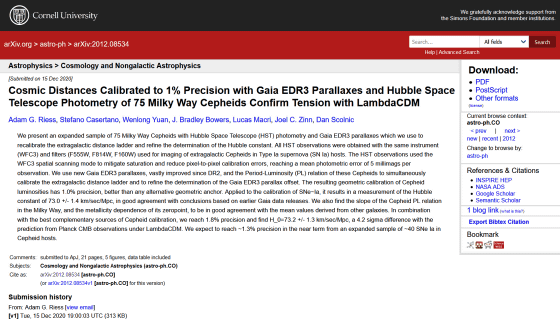The 'distance to the star' dataset measured by the space telescope is updated, deepening the 'mystery about the expansion speed of the universe'

Knowing the 'exact distance to the celestial body' is very important in astronomical research, and the
Cosmic Distances Calibrated to 1% Precision with Gaia EDR3 Parallaxes and Hubble Space Telescope Photometry of 75 Milky Way Cepheids Confirm Tension with Lambda CDM
https://arxiv.org/abs/2012.08534

Astronomers Get Their Wish, and the Hubble Crisis Gets Worse | Quanta Magazine
ESA's Gaia Mission Releases Data on More Than 1.8 Billion Stars | Astronomy | Sci-News.com
http://www.sci-news.com/astronomy/gaia-early-third-release-09116.html
Astronomers have been trying to measure accurate distances from Earth to stars for many years, one of which is the ESA's Gaia program. The Gaia project is to launch a space telescope at the Lagrange point , which is about 1.5 million km from the earth, and observe the position of stars while orbiting the sun as the earth revolves.
To measure the distance from the earth to a star, we use a phenomenon called ' annual parallax, ' in which the position of a distant star changes due to the effect of parallax caused by the orbital motion of the earth. However, since the accuracy of observations from the earth is insufficient, the Gaia project is observing stars using a space telescope launched at the gravitationally stable Lagrange point.
This is an easy-to-understand image of distance measurement using annual parallax. The annual parallax of stars observed by the Gaia Space Telescope, which revolves around the sun with the earth, is larger for stars that are closer to the earth and smaller for stars that are farther away. By taking advantage of this phenomenon, the Gaia project seeks to measure the exact distance to a star.

by Samuel Velasco / Quanta Magazine
The idea of annual parallax has existed for a long time, and 16th-century astronomer
Brae was unable to detect the annual parallax because the star was too far from Earth. The first parallax was confirmed in 1838, when Friedrich Wilhelm Bessel observed the parallax at 61 Cygni . Vessel estimates from the observed parallax that 'the distance from Earth to 61 Cygni is 10.3 light-years away,' which is calculated by the modern Gaia Space Telescope as 'about 11.403 light-years.' It is quite close to the value of 'year'.
61 Cygni is a star that is quite close to the Earth, but stars farther away have very small parallax, so special equipment is required to detect it. The Gaia Space Telescope was designed to measure the annual parallax of such a distant star, equipped with 106 CCD image sensors equivalent to a camera with a resolution of 1 billion pixels, and 500 million per day. We are observing individual stars.
Dr. Floor van Leeuwen, project manager at the Gaia Project Data Processing and Analysis Consortium in the United Kingdom, said, 'The Gaia Space Telescope can be seen from hundreds of millions of light-years away, with the thickness of hair seen from more than 2000 km. 'Sa' is also measured with a detectable accuracy. ' Data from the Gaia Space Telescope is said to be one of the important backbones of astrophysics.

by
The Gaia Space Telescope, launched in 2013, has released two datasets in 2016 and 2018, and on December 3, 2020, it was called ' Gaia Early Data Release 3 (EDR3) '. A third dataset called has been released. This release is one of two parts, with a full release scheduled for 2022.
EDR3 has released detailed information on more than 1.8 billion stars, which is the largest number ever, and astronomers from all over the world are excited about the large amount of data. 'We are overwhelmed by information,' said Wendy Friedman, a researcher at the University of Chicago. Adam Riess of Johns Hopkins University, who won the Nobel Prize in Physics for his research on the accelerated expansion of the universe in 2011. 'I'm extremely excited,' he said.
Reese's research team published a paper on the expansion rate of the universe based on the EDR3 dataset, reporting that the Hubble constant, which indicates the expansion rate of the universe, is 73.2 km / s megaparsec, with an error of 1.8%. did. This shows that the expansion speed of the universe increases by 73.2 km per second for every 1 megaparsec away from the earth, which exceeds the previously assumed value of 67 km per second megaparsec. Reese and colleagues say they used the annual parallax of 75 new Cepheid variables found in the EDR3 dataset to readjust the expansion of the universe.
The mystery that the Hubble constant predicted from known cosmology does not match the Hubble constant based on the latest data and that 'the universe is expanding faster than expected' has been pointed out for some time. This paper, published by Reese's research team, confirms a similar discrepancy in the more accurate EDR3 dataset.

Related Posts:
in Science, Posted by log1h_ik







